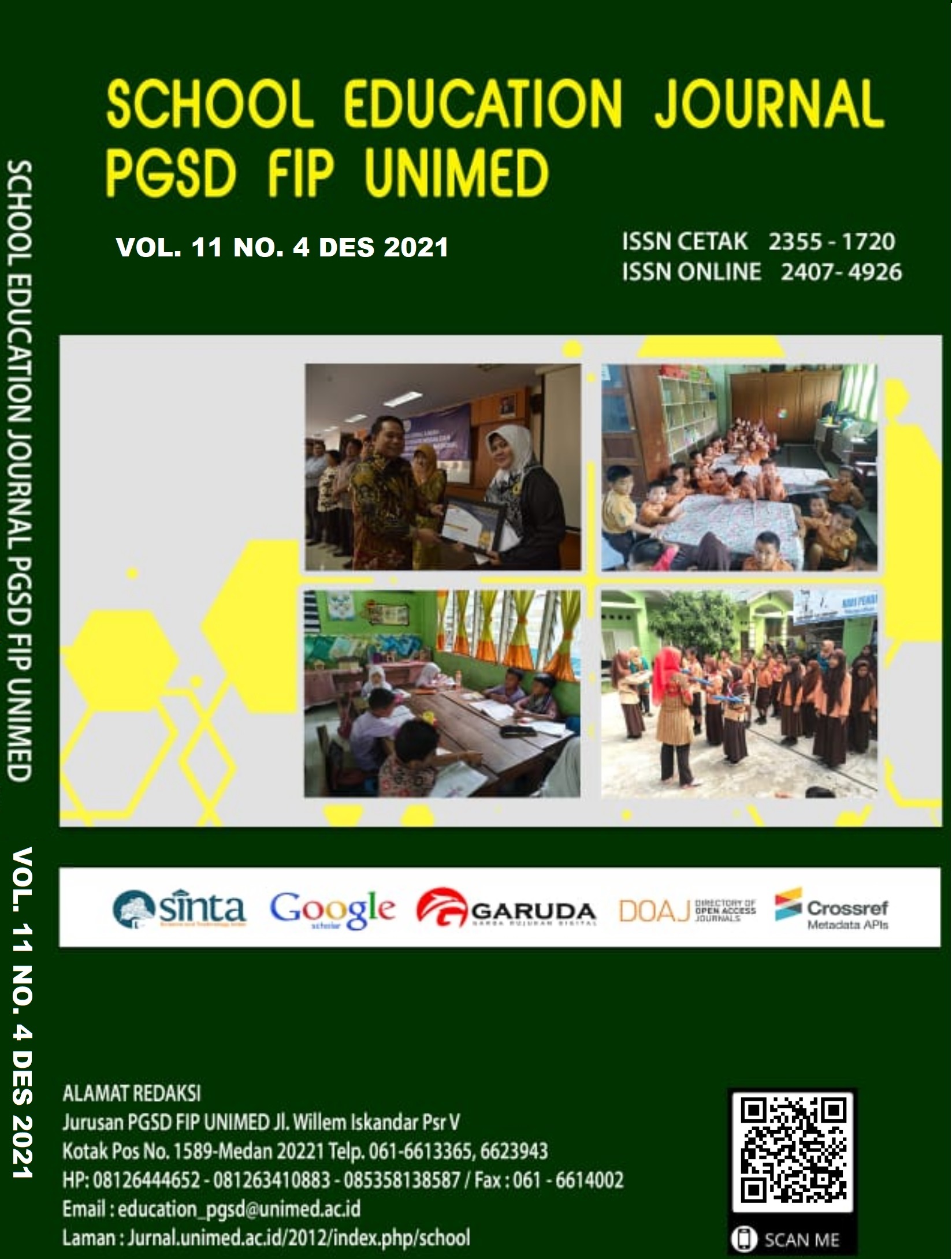PENGEMBANGAN VIDEO PEMBELAJARAN BERBASIS TPACK DALAM MATERI PECAHAN UNTUK SISWA KELAS IV SD
DOI:
https://doi.org/10.24114/sejpgsd.v11i4.29431Keywords:
Pengembangan video pembelajaran, TPACK, pecahanAbstract
This study aims to develop TPACK-based learning videos in fraction material for fourth grade elementary school students that are valid, practical and have a potential effect on student learning outcomes. This research is research and development using the ADDIE model with five stages, namely analysis, design, development, implementation, and evaluation. The research took place at SDN 79 Prabumulih. The research subjects were 20 fourth grade elementary school students. Data collection was carried out by means of a media expert validation questionnaire, material expert, student response questionnaire, and student test questions. The data are analyzed quantitatively and qualitatively. The validation results of the validators got an average validation score of 95.43% with a very valid category. The results of student responses based on small group trials got an average score of 94.87% with a very practical category. The results of the large group trial get an average of 88.25% in the very good category or have a potential effect on student learning outcomes. It can be concluded based on the results of data analysis of TPACK-based learning videos in fraction material for fourth grade elementary school students including learning videos that are valid, practical, and have a potential effect on learning outcomes. Overall, TPACK-based learning videos in fraction material for fourth grade elementary school students have been suitable for use in learningKeywords : Development Of Learning Videos, TPACK, FractionsReferences
Al Farizi, Z., Sulisworo, D., Hasan, M. H., & Rusdin, M. E. 2019. Pengembangan Media Animasi untuk Mendukung Pembelajaran Berbasis TPACK dengan POWTOON pada Materi Torsi SMA Kelas XI. Jurnal Penelitian Pembelajaran Fisika, 10 (2), 108“113.
Ekayani, P. 2017. Pentingnya penggunaan media pembelajaran untuk meningkatkan prestasi belajar siswa. Jurnal Fakultas Ilmu Pendidikan Universitas Pendidikan Ganesha Singaraja, 2(1), 1“11.
Huda M. 2017. Model-Model Pengajaran dan Pembelajaran. Yogyakarta : Pustaka Belajar
Mamin, R., & Arif, R. N. H. 2019. Efektivitas media pembelajaran avideo tutorial terhadap hasil belajar mahasiswa pada Matakuliah IPA Sekolah. Seminar Nasional LP2M UNM.
Meryansumayeka, M., Yusuf, M., & Suganda, V. A. 2018. Pengembangan video pembelajaran berbasis PMRI untuk mendukung mental calculation siswa dalam permasalahan aritmatika sosial. Jurnal Elemen, 4(2), 119“130.
Nahdi, D. S., & Cahyaningsih, U. 2019. Keterampilan Guru SD Dalam Menghadapi Era Revolusi Industri 4.0. Social, Humanities, and Educational Studies (SHEs): Conference Series, 2(1), 57“63.
Octavyanti, N. P. L., & Wulandari, I. G. A. A. 2021. Pengembangan Video Pembelajaran Berbasis Pendekatan Kontekstual Pada Mata Pelajaran Matematika Kelas IV SD. Jurnal Edutech Undiksha, 9(1).
Sintawati, M., & Indriani, F. 2019. Pentingnya Technological Pedagogical Content Knowledge (TPACK) Guru di Era Revolusi Industri 4.0. Prosiding Seminar Nasional Pagelaran Pendidikan Dasar Nasional (PPDN) 2019, 1(1), 417“422.
Sharli, Y, A., Nila, K., & Misdalina 2021. Develompent of social Aritmetic Teaching Materia; Using IT based PMRI Approach For SMP Students. Jurnal Pendidikan Matematika, 15(02) 191-202
Sugiyono. 2019. Metode Penelitian pendidikan. Bandung: Penerbit Alfabeta
Syamsuar, S., & Reflianto, R. 2019. Pendidikan dan tantangan pembelajaran berbasis teknologi informasi di era revolusi industri 4.0. E-Tech: Jurnal Ilmiah Teknologi Pendidikan, 6(2).
Wisada, P. D., & Sudarma, I. K. 2019. Pengembangan media video pembelajaran berorientasi pendidikan karakter. Journal of Education Technology, 3(3), 140“146.
Yuanta, F. 2020. Pengembangan Media Video Pembelajaran Ilmu Pengetahuan Sosial pada Siswa Sekolah Dasar. Trapsila: Jurnal Pendidikan Dasar, 1(02), 91“100.
Downloads
Published
Issue
Section
License
Authors whose manuscripts are approved are approved as follows:
The publication rights for all journal manuscript materials published/published on the SEJ (School Education Journal) E-Journal site are held by the editorial board with the author's knowledge (moral rights remain with the manuscript authors).
The formal legal requirements for accessing this electronic digital journal article are subject to the terms of the Creative Commons Attribution-ShareAlike (CC BY) license, which means that E-Journal SEJ (School Education Journal) has the right to store, transfer media/format, manage in the form of a database, maintain, and publish articles without asking permission from the author as long as the author's name remains as the copyright owner.
Manuscripts published/published electronically are open access for educational, research, and library purposes.

